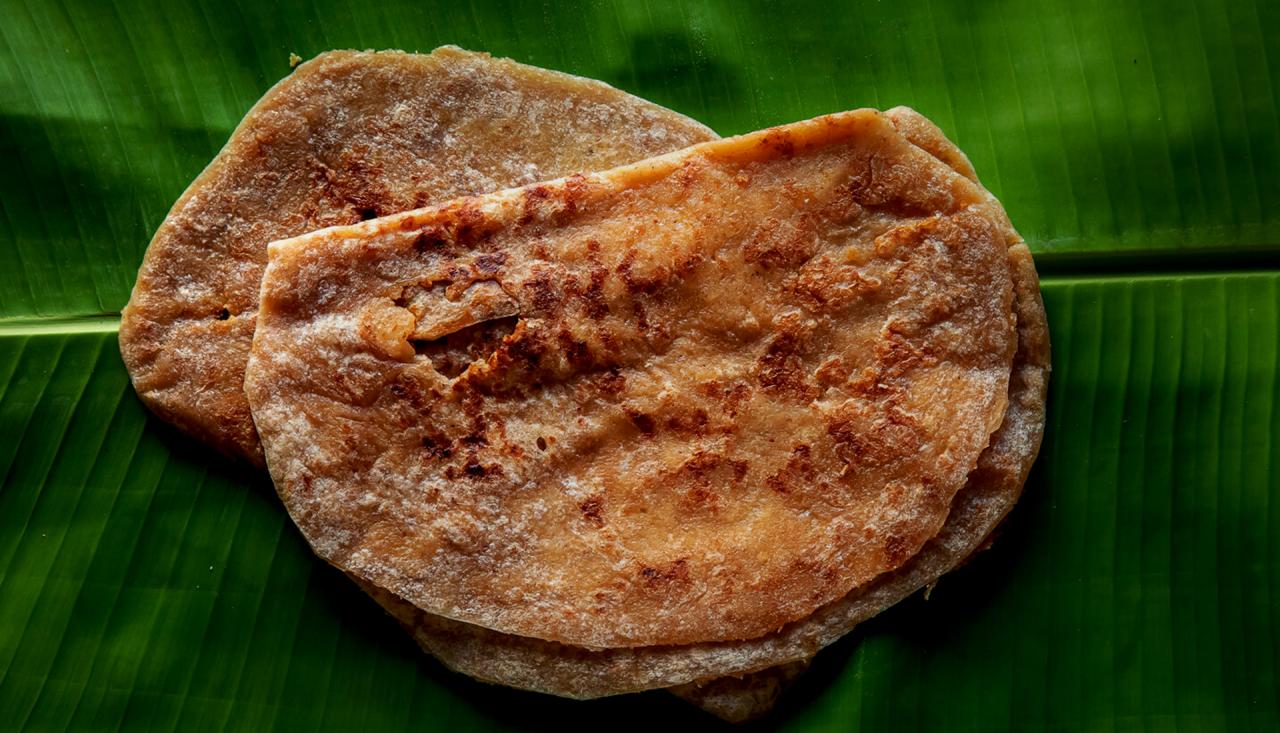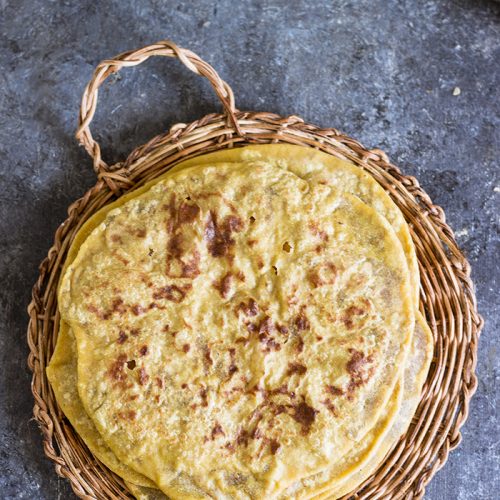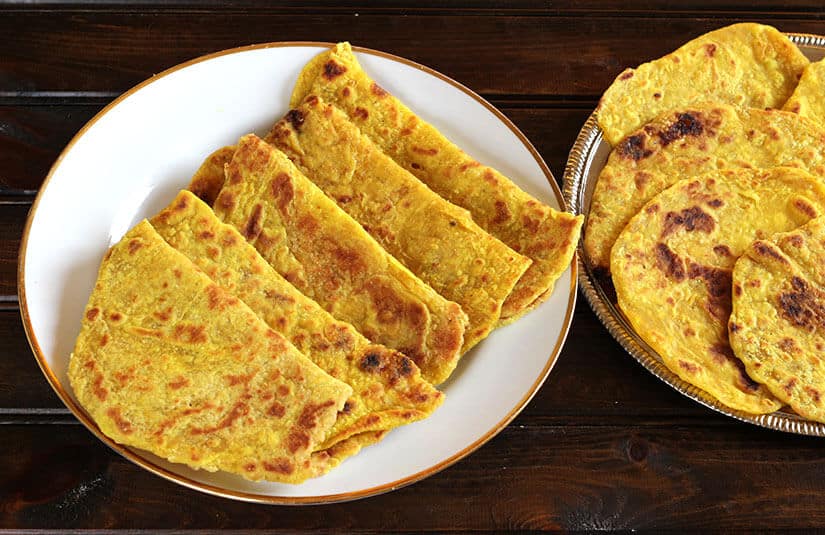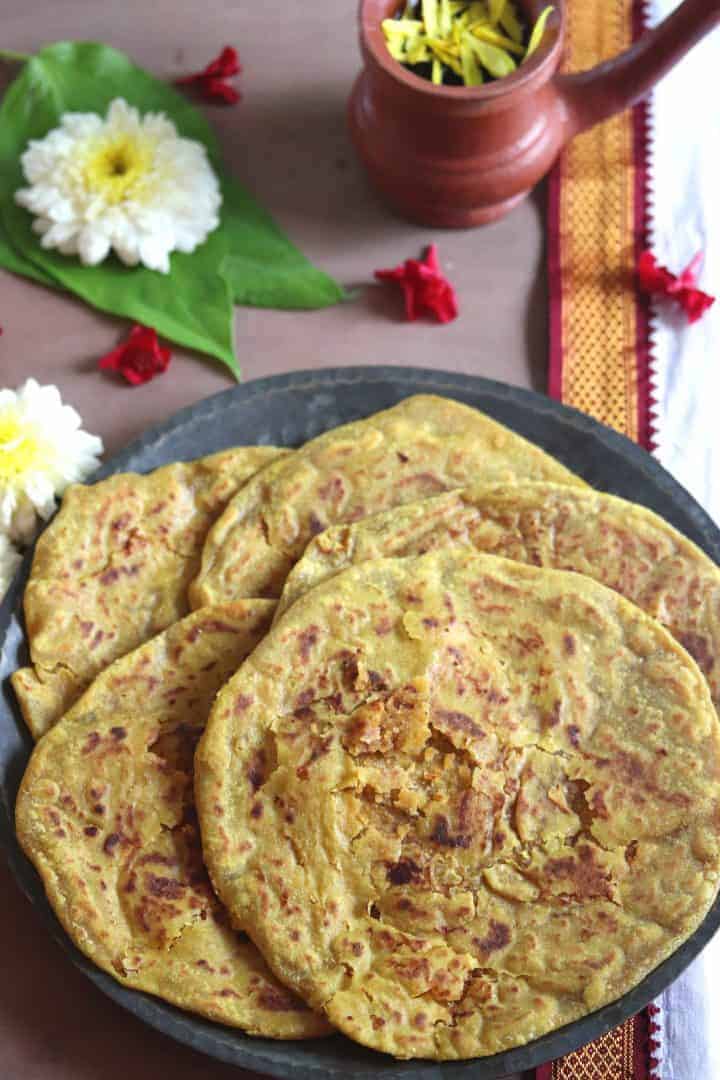Obbattu, also known as Holige in certain regions, is a traditional Indian sweet flatbread that holds a special place in the culinary traditions of several Indian states, including Karnataka, Maharashtra, Andhra Pradesh, and Gujarat, among others. Each region has its own variation, both in terms of the name and the preparation method, making Obbattu a versatile and cherished dish across the country.
The core of Obbattu consists of a sweet filling enveloped within a thin layer of dough. The filling is typically made from jaggery or sugar combined with toor dal (pigeon pea lentil) or chana dal (split chickpeas), and flavored with cardamom and nutmeg. Some variations include coconut in the filling, offering a delightful contrast of textures and flavors. The outer dough is usually made from maida (refined flour), atta (whole wheat flour), or a mixture of both, contributing to its soft yet firm texture.
Obbattu is traditionally prepared during important festivals and celebrations such as Ugadi (the Kannada and Telugu New Year), Diwali, and Ganesh Chaturthi, serving as a symbol of joy and festivity. In many homes, the preparation of Obbattu is a family affair, with members coming together to roll out the dough, prepare the filling, and cook these sweet flatbreads to perfection on a griddle.
Obbattu Recipe


Obbattu
Equipment
- 1 medium bowl
- 1 electric pressure cooker
Ingredients
FOR THE DOUGH
- 1/2 cup all-purpose flour plus more for dusting
- 1/4 teaspoon ground turmeric
- 1/8 teaspoon salt
- 1/8 teaspoon baking soda
- 1/4 cup water
- 2 tablespoons sesame oil
FOR THE STUFFING
- 10 teaspoons ghee divided, plus more for serving
- 1/4 cup Bengal gram rinsed well and drained
- 1 cups water
- 1/2 cup powdered jaggery
- 1/4 teaspoon ground cardamom
- 1/4 cup shredded fresh coconut or frozen, thawed to room temperature (optional)
- Vegetable or corn oil for greasing
Instructions
TO MAKE THE DOUGH
- In a medium bowl, stir together the flour, turmeric, salt, and baking soda.
- While stirring, slowly add the water to form a smooth dough.
- Stir in the sesame oil. Let the dough rest for 30 to 45 minutes, or up to 2 hours.
TO MAKE THE STUFFING
- While the dough rests, prepare the stuffing. In a medium skillet over medium heat, melt 1 teaspoon of ghee.
- Add the Bengal gram and roast for about 3 minutes, until it turns light brown. Remove from the heat and let cool.
- In an electric pressure cooker, such as the Instant Pot®, or a stovetop pressure cooker or pressure pan, combine the cooled Bengal gram and water.
- For an electric pressure cooker, lock the lid into place and make sure the valve is in the Sealed position. Select Pressure Cook or Manual and set the time to 8 minutes on High Pressure. Let the pressure release naturally. For a stovetop pressure cooker, place it over medium heat and place the lid on. Ensure the sealing ring is on and place the weight on. Pressure cook until the cooker “whistles” 2 times. Let the pressure release naturally.
- Carefully unlock and remove the lid and drain the Bengal gram. Let cool. Transfer it to a blender and add the jaggery, cardamom, and coconut (if using). Process until a smooth paste forms.
- In a medium skillet over medium heat, melt 3 teaspoons of ghee.
- Add the ground Bengal gram paste and cook for about 5 minutes until all the moisture is absorbed. Turn off the heat. When cool enough to handle, but still warm, form the stuffing mixture into six small lime-size balls. Set aside.
- Pinch off a lemon-size piece of dough and flatten it into a 2- inch circle. Place 1 stuffing ball in the center and wrap the dough around it. Gently roll this into a smooth ball. Dust a rolling pin and clean work surface with flour. Roll the stuffed dough into a 4-inch circle. Repeat this step with the remaining dough and stuffing.
- Heat a griddle over medium heat.
- Carefully place a flatbread on the griddle and cook for 45 seconds. Flip the flatbread and spread 1 teaspoon of ghee around the edges of the dough. Cook for 45 seconds. The bread will puff up slightly. When you see small brown spots, remove the bread from the griddle. Repeat this step with the remaining flatbreads and ghee.
- Serve the obbattu warm with a dollop of ghee.
Notes
flour is used for this flatbread, but you can use half whole-wheat flour and half all-purpose flour. This recipe does need flour with gluten.
Cooking Tips about Obbattu

- Choosing the Right Flour: The dough’s texture is crucial for Obbattu. A mixture of maida (refined flour) and atta (whole wheat flour) is commonly used. The ratio can be adjusted based on personal preference for softness and health considerations, with maida making it softer and atta giving a healthier twist.
- Preparation of the Dough: The dough should be kneaded to a smooth, pliable consistency, similar to that of bread or pizza dough. Adding a little bit of oil or ghee while kneading can prevent it from sticking and help in creating a soft dough that’s easy to work with.
- Creating the Filling: The filling, typically made from toor dal (pigeon pea lentil) or chana dal (split chickpeas) combined with jaggery or sugar, should be cooked until it is soft. Ensure that it’s not too wet, as excess moisture can make rolling the Obbattu difficult. For added flavor, infuse the filling with cardamom powder and a hint of nutmeg.
- Rolling the Obbattu: Rolling out the Obbattu evenly without tearing is perhaps the most challenging step. To prevent sticking, you can roll it between two sheets of greased plastic or parchment paper. Start with placing a ball of dough, flattened slightly, then add the filling in the center, and close it up to seal. Gently roll it out to the desired thickness, ensuring even distribution of the filling.
- Cooking on the Griddle: Cook the Obbattu on a hot griddle or tawa until golden brown spots appear on both sides. A common practice is brushing it with a bit of ghee while cooking, which enhances the flavor and gives it a nice, crisp outer layer while keeping the interior soft.
- Resting Time: Allow the cooked Obbattu to rest for a few minutes before serving. This resting period lets the steam distribute throughout the Obbattu, making it softer and bringing out the flavors more intensely.
- Customization: Don’t hesitate to customize the filling according to your taste. Adding coconut, sesame seeds, or even a pinch of edible camphor can create diverse flavor profiles.
- Storing Obbattu: If not served immediately, Obbattu can be layered between pieces of parchment paper and stored in an airtight container. They can be reheated on a griddle or microwave before serving.
Serving suggestions about Obbattu

- Served Warm with Ghee: Obbattu tastes exquisite when slightly warmed and brushed with a dollop of ghee on top. The warmth augments the flavors, and the ghee adds a rich, melt-in-your-mouth texture.
- Paired with Milk or Coconut Milk: For those who enjoy a balance of flavors, serving obbattu with a side of warm or cold milk can be refreshing. A vegan alternative is coconut milk, which complements the sweetness of the obbattu with its creamy, tropical flavor.
- Accompanied by Sweet Syrup: If you enjoy an extra burst of sweetness, try serving obbattu with a drizzle of sweet syrup. Jaggery syrup or a cardamom-infused sugar syrup can enhance the flavors and add a moist texture.
- As Part of a Festive Thali: Include obbattu in a festive thali (platter) during celebrations. It can be an integral part of a larger meal, providing a sweet counterpoint to the savory dishes on the platter.
- With Vanilla Ice Cream: For a fusion twist, serve a slice of warm obbattu with a scoop of vanilla ice cream on the side. The contrast between the warm flatbread and the cold ice cream makes for an irresistible combination.
- Room Temperature as a Snack: Obbattu can also be enjoyed at room temperature as a snack or a treat with tea. Its inherent sweetness and soft texture make it ideal for a mid-day pick-me-up.
- Reheated on a Griddle: To revive the freshness of obbattu that has been stored, lightly reheat it on a griddle or in a microwave. This will soften the flatbread and bring out its flavors as if it were just made.
- Presentation: While the taste is paramount, presentation can enhance the dining experience. Serve obbattu on traditional crockery or colorful plates, garnished with a sprinkle of powdered sugar or finely chopped nuts for visual appeal.
Top 5 FAQs about Obbattu

- What is Obbattu? Obbattu, also known as Holige in certain regions, is a traditional Indian sweet flatbread made from a mixture of flour for the outer layer and a sweet filling usually containing jaggery or sugar, toor dal (pigeon pea lentil) or chana dal (split chickpeas), flavored with cardamom and nutmeg. It is a popular dish in several Indian states including Karnataka, Maharashtra, Andhra Pradesh, and Gujarat, among others.
- How does the preparation of Obbattu vary across regions? While the basic ingredients remain similar, regional variations of Obbattu may include differences in the type of flour used for the dough (maida, atta, or a mix), the choice between jaggery and sugar, and additional fillings like coconut. Each region brings its own twist to the recipe, reflecting local tastes and preferences.
- When is Obbattu typically served? Obbattu is traditionally prepared during important festivals and celebrations such as Ugadi (the Kannada and Telugu New Year), Diwali, and Ganesh Chaturthi. It symbolizes joy and festivity, often bringing family members together for the preparation process.
- What are some tips for making perfect Obbattu? Key tips include choosing the right combination of flours for the dough, ensuring the filling is not too wet for easy rolling, cooking on a hot griddle until golden with spots, and allowing it to rest before serving. Patience and practice play essential roles in mastering the art of making Obbattu.
- How can Obbattu be served? Obbattu can be enjoyed warm or at room temperature, either plain or with a dollop of ghee or milk to enhance its flavor. It is versatile enough to be served as part of a festive meal, or as a standalone snack or dessert.
Obbattu, with its rich history and diverse regional variations, is more than just a culinary delight; it epitomizes the essence of Indian cultural and festive traditions. This treasured sweet flatbread, known by various names like Holige in some parts and by other names across different states, serves as a symbol of joy, unity, and the spirit of celebration. The meticulous process of making Obbattu – from preparing the dough and the sweet filling to cooking it to perfection – reflects the deep-rooted culinary skills, patience, and passion that have been passed down through generations.

Leave a Reply